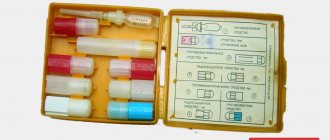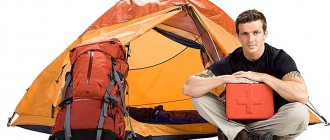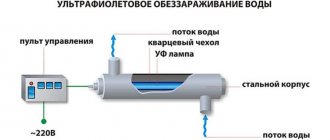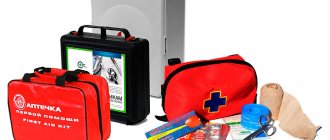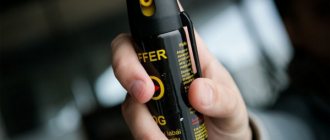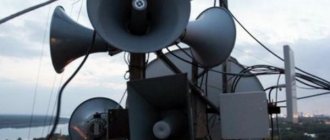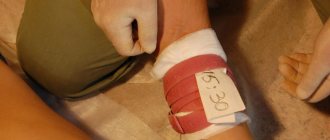An individual first aid kit is a set of medical self-help equipment for a serviceman.
The first aid kit is designed to provide self- and mutual assistance, prevent or mitigate the damaging effects of radiation substances (RS), bacterial agents (BS) and organophosphorus toxic substances (FOB), as well as to provide first aid for mechanical and thermal injuries to personnel.
The first aid kit contains a set of medical supplies, distributed into slots in a plastic box. The size of the box is 90x100x20 mm, the weight of AI-2 is 130 g. The size and shape of the box allows you to carry it in your pocket, the pocket of a gas mask bag and always have it with you.
- Each medicine in the medicine cabinet is located in a strictly defined place; the order of placement is indicated on the inside of the lid.
Individual first aid kit AI-2
- In slot 1, in a syringe tube with a white cap, there is an analgesic (promedol).
It is used for bone fractures, extensive wounds and burns, as an anti-shock agent, by injection into the soft tissue of the thigh or arm. The injection can be given through clothing.
In slot 2, in a red round pencil case with four semi-oval protrusions on the body, there is a means for preventing poisoning by organophosphorus toxic substances (taren antidote), 6 tablets of 0.3 g each.
If there is a threat of poisoning, take an antidote (one tablet), and then put on a gas mask.
If signs of poisoning appear and increase (deterioration of vision, sudden shortness of breath), you should take another tablet. Repeated use is recommended no earlier than after 5-6 hours.
In slot 3, in a large round pencil case without coloring, there is antibacterial agent 2 (sulfadimethoxine), 15 tablets of 0.2 g each. The drug should be used for gastrointestinal disorders that occur after radiation damage.
On the first day, take 7 tablets (in one dose), and in the next two days - 4 tablets.
This drug is a means of preventing infectious diseases that may arise due to the weakening of the protective abilities of the irradiated organism.
In slot 4, in two pink octagonal pencil cases, there is radioprotective agent No. 1 (cystamine), 12 tablets of 0.2 g each. Take it for personal prophylaxis in case of threat of radiation damage, 6 tablets immediately and preferably 30-60 minutes before irradiation.
In slot 5, in two tetrahedral pencil cases without painting, there is antibacterial agent No. 1 - a broad-spectrum antibiotic (chlortetracycline hydrochloride), 10 tablets of 1,000,000 units each.
It is taken as a means of emergency prevention in case of threat of infection by bacterial agents or in case of infection by them, as well as in case of wounds and burns (to prevent infection).
First, take the contents of one pencil case - 5 tablets at once, and then after 6 hours take the contents of another pencil case - also 5 tablets.
In slot 6, in a white tetrahedral pencil case with longitudinal semi-oval cutouts in the walls of the edges, there is radioprotective agent No. 2 (potassium iodide), 10 tablets.
The drug should be taken one tablet daily for 10 days after a nuclear power plant accident and if a person eats food from an area contaminated with radioactive substances.
The drug prevents the deposition of radioactive iodine in the thyroid gland, which enters the body from the external environment.
In slot 7, in a blue round pencil case with six longitudinal protruding stripes, there is an antiemetic agent (etaperazine), 5 tablets of 0.004 g each. Take 1 tablet for head bruises, concussions and contusions, as well as immediately after radiation exposure to prevent vomiting. If nausea continues, take one tablet every 3-4 hours.
During the cold season, it is recommended to carry an AI first aid kit in the chest pocket of your uniform to prevent freezing of liquid medicines.
The medicines contained in the first aid kit are used depending on the indications, both as directed by the commander (senior), and independently in accordance with the instructions that are communicated to the personnel before performing a combat mission.
The following medications are used independently, if indicated: - a remedy for poisoning with FOV - at the first signs of damage; - an analgesic - for injuries and burns accompanied by severe pain; - an antibacterial agent - for wounds and burns; antiemetic - in case of nausea caused by exposure to ionizing radiation, as well as concussions and other factors. Only at the command (instruction) of the commander, use: - a radioprotective agent; - an antibacterial agent - in case of danger of infection with pathogens of infectious diseases; - a prophylactic agent against FOV poisoning ( tablets) - in anticipation of the sudden use of chemical weapons by the enemy; - antiemetic - in anticipation of exposure to radiation in large doses.
— The established dosages of medications must be strictly observed to avoid a decrease in their effectiveness or negative effects on the body. For this purpose, first aid kits contain syringe tubes.
Rules for using a syringe tube
- Remove the syringe tube from the first aid kit and, holding it in one hand, grasp the ribbed rim with the other. - With a rotational movement, vigorously push the rim until it stops, and then remove the cap protecting the needle. - Without touching the needle with your hands, inject it into the soft tissue of the thigh in the upper third from the outside (you can through clothing). - Squeezing the tube tightly with your fingers, squeeze out the contents and remove the needle without unclenching your fingers.
— A remedy for poisoning with FOV — the contents of one syringe tube with a red cap should be used at the first signs of damage: blurred vision, difficulty breathing, drooling.
The earlier the antidote is applied, the higher its effectiveness.
Use the second syringe tube with a red cap 5-7 minutes after administering the contents of the first syringe tube in cases where the signs of damage continue to grow (intensify).
- Syringe tube
- In order to provide mutual assistance in case of severe lesions, accompanied by severe difficulty breathing, convulsions, loss of consciousness, administer the medicine from two syringe tubes at once.
- An anti-pain remedy from a syringe tube with a white cap should be used for severe pain caused by fractures, extensive wounds, crushed tissue and burns.
- Used syringe tubes must be pinned to the clothes on the chest of the affected person to record the amount of antidote administered when carrying out further treatment measures.
- When using an antidote, it is necessary to strengthen control over one’s own condition and the condition of other military personnel, especially when performing combat missions at night, during monotonous activities and elevated ambient temperatures.
- To prevent side effects and disturbances in heat exchange that may occur when using the drug for poisoning with OPV, these antidotes should be administered only when there are the first signs of damage to OPV.
Individual first aid kit AI-4
The AI-4 first aid kit is designed to replace the AI-2 first aid kit, which does not meet modern requirements. The AI-4 first aid kit contains the entire range of medications necessary to protect the population. The new first aid kit is designed to provide self- and mutual first aid, prevent or mitigate the damaging effects of radioactive substances (RS), bacterial agents (BA), organophosphorus substances (OPS) and toxic substances (HAS). AI-4 is equipped with modern, more effective pharmaceuticals. In general, the AI-4 first aid kit best corresponds to the realities of today and can be successfully and effectively used both in reserve and for equipping existing rescue units.
Types of individual first aid kits
The medications in an individual first aid kit are intended to provide first aid to patients. They can provide pain relief for burns and wounds, and provide prevention of infection of the wound surface. There are also means for disinfecting water, washing eyes, for headaches, and to stop bleeding of all localizations. Various troops have the following types of first aid kits:
- AD - airborne. It is equipped with personnel of air and naval landing forces. Weighs 400 g and is in a protective case;
- AVI - individual diving. Special purpose combat swimmers are equipped with it;
- AA - emergency, equipped with flight personnel.
First aid kit AI-3
This type of first aid kit was developed at the Institute of Military Field and Extreme Medicine. It meets all first aid requirements.
The main indications for the use of AI-3 are injuries of varying severity, shock, concussion, radiation injury, and chemical poisoning.
It contains:
- Promedol is a narcotic analgesic that can be used for any injuries and fractures. It is administered intramuscularly. It comes in two syringe tubes.
- Dressing package. It consists of a movable (or fixed) cotton-gauze pad that can be applied to the wound surface, and a bandage for fixation.
- Hemostatic rubberized or knitted tourniquet. Used to instantly stop venous and arterial bleeding of the upper and lower extremities. The tourniquet should not be used for more than 2 hours.
- Antidote for chemical damage - Athens.
- Radioprotective agent (for radiation exposure) – cystamine.
- Antibiotic – Doxycycline, used according to the scheme to prevent infectious contamination of wounds and burns.
- Antibacterial agent – Sulfadimethoxine.
- Anti-nausea and vomiting drug – Etaperazine. It is used in cases of uncontrollable vomiting (head injury, concussion, shock).
- A means for disinfecting water from unknown sources.
All ampoules and syringe tubes are in a special ampoule, which protects them from mechanical damage. You can use the following tools yourself:
- antidote – when the first signs of chemical poisoning appear;
- antiemetic - during nausea with concussion;
- analgesic – burns, injuries with severe pain.
The commander may issue an order for all personnel to take radioprotective, antibacterial or antiemetic agents (if there is a threat of radiological contamination).
3.1. Individual first aid kit (AI). Purpose, procedure and rules of use
An individual first aid kit is a set of medical self-help equipment for a serviceman. The first aid kit is designed to prevent or reduce the damaging effects of various types of modern weapons, as well as to provide first aid in case of injuries to personnel.
The contents of the first aid kit (syringe tubes and pencil cases) are placed in a plastic box and held by the internal partitions of the case. Each medicine in the medicine cabinet is located in a strictly defined place; the order of placement is indicated on the inside of the lid (Fig. 1).
In slot 1 there is a syringe tube (with a red cap) containing an antidote (antidote) against organophosphate toxic substances (VX, sarin, soman).
Slot 2 is a reserve one; in some first aid kits it may have the same syringe tube as in slot 1. Instead of syringe tubes, slots 1 and 2 can contain reusable automatic syringes with several attachment parts containing an antidote against organophosphorus toxic substances.
In slot 3 there is a syringe tube (with a white cap) containing an analgesic that is injected under the skin to reduce pain from wounds, burns and fractures.
In slot 4, two crimson pencil cases contain 12 radioprotective tablets.
If there is a threat of exposure to penetrating radiation, when operating in areas contaminated with radioactive products of a nuclear explosion, six tablets are taken at once. This dose is effective for 4–5 hours.
If activities continue in the contaminated area, you must take the remaining six tablets.
In slot 5, two white rectangular pencil cases contain eight tablets of an antibacterial agent. In case of wounds, burns or the threat of bacteriological (biological) infection, eight tablets of the drug are taken simultaneously, and after 6–8 hours, eight tablets from the second pencil case are taken again.
Slot 7, in a round ribbed blue pencil case, contains tablets of etaprazine, an antiemetic. It is taken one tablet in cases of signs of a primary reaction to radiation exposure (nausea, vomiting), as well as when these disorders occur as a result of concussion or injury.
- Weight of the first aid kit is 100 g.
- During the cold season, it is recommended to carry a first aid kit in the chest pocket of your uniform to prevent liquid medications from freezing.
- The medicines contained in the first aid kit are used depending on the indications, both as directed by the commander (senior), and independently in accordance with the instructions that are communicated to personnel during military medical training.
- The following medications are used independently, if indicated: a remedy for poisoning with FOV - at the first signs of damage; analgesic - for injuries and burns accompanied by severe pain; antibacterial agent - for wounds and burns; antiemetic - for nausea caused by exposure to ionizing radiation, as well as contusions and other factors.
- Only at the command (instruction) of the commander is used: radioprotective agent; antibacterial agent - in case of danger of infection by pathogens of infectious diseases; prophylactic against poisoning FOV (tablets) - in anticipation of the sudden use of chemical weapons by the enemy; antiemetic - in anticipation of exposure to radiation in large doses.
The prescribed dosages of medications must be strictly observed to avoid a decrease in their effectiveness or negative effects on the body.
To use the syringe tube you must
(Fig. 2):
- remove the syringe tube from the first aid kit;
- take the ribbed rim of the cannula with one hand, the body with the other and turn the body clockwise until it stops - to pierce the membrane;
- take the syringe tube by the cannula, remove the cap protecting the needle;
- holding the syringe tube by the ribbed rim of the cannula and without squeezing the tube with your fingers, insert the needle into the soft tissues of the thigh, buttock or shoulder (you can through clothing) to the cannula;
- squeeze out the contents of the tube by squeezing its body;
- Without unclenching your fingers, remove the needle.
Individual first aid kit AI1 - AI4, composition and contents of the army medical universal kit
An individual first aid kit for a serviceman is a special set of medical products and medications designed to provide individual or collective emergency care for various burns, wounds and other extreme situations, directly in combat conditions. What are the main types of these products? How to wear it correctly? You will read about this and much more in our article.
Types of army medical kits
There are several types of military first aid kits. In general, they can be individual or collective, intended for combat personnel or paramedics working in military field conditions, as well as civilian needs.
Basic types of military first aid kits include:
- Individual medical first aid kit . It is often called a tactical first aid kit. It includes 4 main classes with several varieties and is briefly labeled as AI. At the same time, AI-1 and AI-3 with modifications are intended for military needs. AI-2 and AI-4 are simplified versions for ordinary residents and are used as personal protective equipment within the framework of civil defense;
- Military first aid kit. It is an expanded set of medications and drugs that are used to equip wheeled and tracked vehicles in the armed forces of the Russian Federation. Allows you to provide first emergency medical aid to 3-5 wounded crew members;
- VF kit. It is an expanded functional set of medicines and various medications intended for the systemic provision of first emergency medical care. The paramedic military kit most often acts as a staff unit for a medical platoon or battalion. In addition, they are equipped with sections of evacuation routes and places of military operations. It is used not only by the military and is currently in service with civilian emergency services; in addition, a certain number of them are stored in civil defense and emergency warehouses.
Composition of a military personal first aid kit
Currently, the Russian army uses modern personal protective equipment, including an appropriate medical kit. However, throughout the country you can still find variations of individual sets for military or civilian needs of previous modifications.
AI-1
The first modification of the AI-1 first aid kit was accepted for supply back in 1978. Designed to prevent shock in case of injuries, wounds, as well as provide medical care in case of bacterial, chemical or radiation damage.
The basic composition of the army personal first aid kit AI-1 includes:
- Two syringe tubes with Athene or Budaxim. Intended for use in case of poisoning with FOV;
- One syringe tube with an analgesic of the narcotic spectrum. Most often they receive a solution of promedol. Included optionally by special permission;
- Cystamine tablets. Acts as a radioprotective agent;
- Antibiotic in tablet form. Previously, tetracycline hydrochloride was used, after 1987 it was replaced by vibromycin;
- Antidote . Supplied optionally depending on specific potential military conditions. Most often it was a combination of phenazepam, aminostigmine and fluoroacyzine or potassium iodide;
- Etaperazine tablets. A strong antiemetic.
In the more modern variation AI-1, accepted for supply already in 1995, poisoning prevention agents, antiseptics, and water disinfection solutions were added to the drugs described above.
AI-2
The civilian version of the AI-1 is currently considered obsolete. Intended for emergency treatment in situations involving the use of weapons of mass destruction, as well as mutual aid for wounds.
The basic composition of the AI-2 first aid kit included 2 radioprotective and antibacterial agents, as well as an antiemetic drug.
In addition, until 1995, the composition contained aprofen, which is an antidote to damage from organophosphorus compounds.
Variations of the AI-2 personal first aid kit, previously used by non-military law enforcement officers, also included the narcotic opioid analgesic and athens.
AI-3
At the moment, it is the main option for an individual military first aid kit; it contains a universal set of emergency first aid equipment.
What are army medical universal kits made of, first aid kits AI-1 - AI-4
An individual first aid kit contains medications that are used to provide mutual or self-help in extreme conditions, in wartime, in the event of mass casualties. This medical kit is used for:
- Burns, mechanical damage to the skin, wounds;
- Radiation exposure;
- Exposure to chemical warfare agents;
- Defeat by bacteriological weapons.
An individual first aid kit includes 5 main groups of medications:
- Antimicrobial drugs - antibiotics, serums, vaccines, interferons. They protect against viral, bacterial, and protozoal infections.
- Antidotes against toxic chemical compounds. Organophosphorus compounds (sarin, soman) are more often used as toxic substances during combat operations. Antidotes are used after an infection has already occurred or for prophylactic purposes.
- Radioprotectors are substances that reduce the negative effects of ionizing rays on the body. This group includes specific radiation protection agents and substances with sorbing properties that reduce the absorption of radioactive compounds into the bloodstream.
- An antiemetic is used to stop vomiting in cases of radiation sickness, toxic chemical poisoning, or an infectious disease.
- Analgesics are used to relieve severe pain due to injury, thermal or chemical burns. If intense pain is not stopped in time, the risk of developing pain shock increases.
Peculiarities!
The contents of individual first aid kits may vary only slightly, depending on the characteristics of military operations in a particular territory.
What drugs are included in the AI-1 military first aid kit?
One of the most important functions of any military man is considered to be the preservation of people’s lives, but, as a rule, not only those of others, but also his own. For this purpose, each soldier has an individual first aid kit.
First of all, it is worth saying that there are several standard personal first aid kits that are currently in use. These are compositions AI-1, AI-2, AI-3 VS, AI-4. You can also distinguish one of the subtypes AI-1M. The individual first aid kit of the first composition (AI-1) is intended to eliminate severe injuries and injuries due to radiation, chemical and bacterial damage. As a rule, such a first aid kit is compact in size and easily fits in your pocket. This first aid kit is divided into seven sections. Each section contains one drug. For convenience, they are usually distinguished by color. Thus, in section No. 1 there is a syringe tube with a strong analgesic agent. Currently, Promedol is used. This drug is a narcotic, therefore, as a rule, it is not placed in the first aid kit, but is issued upon special request. It is used for severe pain, which can be caused by extensive burns or bone fractures. Section No. 2 contains “Taren”. This drug belongs to the class of prophylactics for poisoning with organophosphorus substances, such as sarin and soman. It is available in tablet form and begins to act 20 minutes after administration. Instead of Taren, Athene or Budaxim can be used. This product has a red cap. Section No. 3 contains “Sulfadimethoxine,” which is an antibacterial agent and is used to prevent infectious diseases after radiation exposure. The product has a colorless cap.
Section No. 4 contains “Cystamine” tablets, which are a radioprotective agent and are used for injuries from ionizing radiation. The set includes two pencil cases with a red cap.
Chlortetracycline with nystatin tablets are used as an antibacterial agent. They are especially effective against infectious diseases such as plague, cholera and anthrax. At the moment, the drug “Vibromycin” is widely used.
The presented products are located in section No. 5 and have colorless packaging.
Section No. 6 contains the radioprotective agent “Potassium iodide”.
It is designed to block radioactive iodine that can enter the body from radioactive fallout.
As a rule, the last section contains “Etaperazine”, which has an antiemetic effect and is used after irradiation. Sometimes Dimertkarb is used instead. Both substances are in blue pencil cases.
Source: https://www.kakprosto.ru/kak-882185-kakie-preparaty-vhodyat-v-voennuyu-aptechku-ai-1
